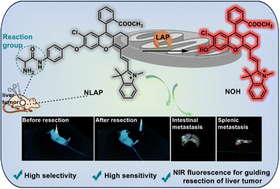Engineering a near-infrared LAP fluorescent probe with high sensitivity and selectivity for surgical resection of liver cancer†
Abstract
Hepatocellular carcinoma (HCC) is a type of cancer associated with a high rate of mortality and morbidity. In order to achieve precise HCC theranostics, it is important to develop excellent fluorescent probes. However, the existing probes are not sensitive or specific enough to accurately identify HCC margins and contours. For diagnosing HCC and identifying tumors during surgery, it is urgent to engineer highly sensitive and selective fluorescent probes. Liver tumor progression is closely associated with leucine aminopeptidase (LAP) overexpression, a biomarker of liver cancer. Herein, we have rationally designed a NIR fluorescent probe, NLAP, which is specially activated by LAP. The probe exhibited high sensitivity (detection limit = 6.8 mU L−1) and superior affinity (Km = 2.98 μM) for LAP. With this probe, we distinguished cancer cells overexpressing LAP from normal cells and applied it intraoperatively to guide liver tumor excisions. Furthermore, NLAP was employed to successfully detect the LAP of intestinal and splenic metastatic tumors in orthotopic liver tumor mice by “in situ spraying” and good performances were demonstrated.

- This article is part of the themed collection: 2023 Journal of Materials Chemistry B HOT Papers


 Please wait while we load your content...
Please wait while we load your content...